RESEARCH
Emergency, anaesthetic and essential surgical capacity in the Gambia
Capacité en termes d'urgence, d'anesthésie et de chirurgie essentielle en Gambie
Capacidad de asistencia de emergencias, asistencia anestésica y asistencia de traumatismos en Gambia
Adam IddrissI,*; Nestor ShivuteII; Stephen BicklerIII; Ramou Cole-CeesayIV; Bakary JargoV; Fizan AbdullahI; Meena CherianVI
IDepartment of Surgery, Johns Hopkins University School of Medicine, Harvey 319, 600 Wolfe Street, Baltimore, MD, 21205, United States of America (USA)
IICountry Office, World Health Organization, Kanifang, Gambia
IIIDepartment of Surgery, University of California at San Diego, San Diego, USA
IVMinistry of Health, Banjul, Gambia
VRoyal Victoria Teaching Hospital, Banjul, Gambia
VIDepartment of Essential Health Technologies, World Health Organization, Geneva, Switzerland
ABSTRACT
OBJECTIVE: To assess the resources for essential and emergency surgical care in the Gambia.
METHODS: The World Health Organization's Tool for Situation Analysis to Assess Emergency and Essential Surgical Care was distributed to health-care managers in facilities throughout the country. The survey was completed by 65 health facilities one tertiary referral hospital, 7 district/general hospitals, 46 health centres and 11 private health facilities and included 110 questions divided into four sections: (i) infrastructure, type of facility, population served and material resources; (ii) human resources; (iii) management of emergency and other surgical interventions; (iv) emergency equipment and supplies for resuscitation. Questionnaire data were complemented by interviews with health facility staff, Ministry of Health officials and representatives of nongovernmental organizations.
FINDINGS: Important deficits were identified in infrastructure, human resources, availability of essential supplies and ability to perform trauma, obstetric and general surgical procedures. Of the 18 facilities expected to perform surgical procedures, 50.0% had interruptions in water supply and 55.6% in electricity. Only 38.9% of facilities had a surgeon and only 16.7% had a physician anaesthetist. All facilities had limited ability to perform basic trauma and general surgical procedures. Of public facilities, 54.5% could not perform laparotomy and 58.3% could not repair a hernia. Only 25.0% of them could manage an open fracture and 41.7% could perform an emergency procedure for an obstructed airway.
CONCLUSION: The present survey of health-care facilities in the Gambia suggests that major gaps exist in the physical and human resources needed to carry out basic life-saving surgical interventions.
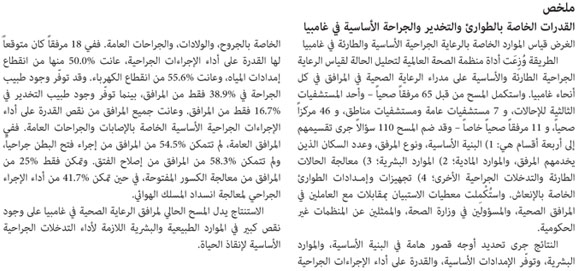

RÉSUMÉ
OBJECTIF: Évaluer les ressources en soins chirurgicaux essentiels et d'urgence en Gambie.
MÉTHODES: L'outil d'analyse de situation pour évaluer les soins chirurgicaux d'urgence et essentiels de l'Organisation mondiale de la Santé a été distribué aux gestionnaires de soins de santé dans les établissements de tout le pays. L'enquête a été remplie par 65 établissements de santé - un hôpital de référence tertiaire, 7 hôpitaux de district/généraux, 46 centres de santé et 11 établissements de santé privés - et comptait 110 questions, réparties en quatre sections: (i) infrastructures, type d'établissement, population traitée et ressources matérielles; (ii) ressources humaines; (iii) gestion des urgences et autres interventions chirurgicales; (iv) équipements d'urgence et de réanimation. Les données du questionnaire ont été complétées par des entretiens avec le personnel des établissements de santé, des fonctionnaires du ministère de la Santé et des représentants d'organisations non gouvernementales.
RÉSULTATS: Des lacunes importantes ont été identifiées en termes d'infrastructures, de ressources humaines, de disponibilité d'équipements essentiels et de capacité à effectuer des interventions de traumatologie, d'obstétrique et de chirurgie générale. Sur les 18 établissements supposés effectuer des interventions chirurgicales, 50.0% rencontraient des interruptions d'approvisionnement en eau et 55,6% en électricité. Seuls 38,9% des établissements disposaient d'un chirurgien et 16,7% d'un médecin anesthésiste. Tous les établissements avaient une capacité limitée pour effectuer des interventions traumatologiques de base et de chirurgie générale. Ce sont 54,5% des établissements publics qui ne pouvaient pas effectuer de laparotomie et 58,3% ne pouvaient pas guérir une hernie. Seuls 25.0% d'entre eux pouvaient traiter une fracture ouverte et 41,7% pouvaient effectuer une intervention d'urgence pour dégager des voies respiratoires obstruées.
CONCLUSION: La présente étude sur les établissements de soins de santé en Gambie suggère d'importantes lacunes en termes de ressources humaines et physiques nécessaires pour effectuer des interventions chirurgicales de base, permettant de sauver des vies.

RESUMEN
OBJETIVO: Evaluar los recursos existentes de la asistencia esencial y de cirugía de emergencia en Gambia.
MÉTODOS: Se distribuyó la herramienta de Análisis de la situación de la Organización Mundial de la Salud para evaluar la asistencia quirúrgica esencial y de emergencia entre gerentes de asistencia sanitaria de instituciones de todo el país. El estudio se llevó a cabo en 65 instituciones sanitarias (un hospital de asistencia sanitaria especializada, 7 hospitales de distrito/generales, 46 centros de salud y 11 centros sanitarios privados) y se incluyeron 110 preguntas divididas en cuatro secciones: (a) infraestructura, tipo de centro, población atendida y recursos materiales; (b) recursos humanos; (c) gestión de las urgencias y otras intervenciones quirúrgicas; (d) equipamiento de urgencias y suministros para reanimación. Los datos del cuestionario se complementaron con entrevistas mantenidas con el personal del centro sanitario, los funcionarios del Ministerio de Sanidad y los representantes de las organizaciones no gubernamentales.
RESULTADOS: Se identificaron deficiencias importantes en las infraestructuras, los recursos humanos, la disponibilidad de suministros esenciales y la habilidad para realizar intervenciones quirúrgicas de traumatología, obstetricia y cirugía general. De los 18 centros en los que se esperaba que se realizaran procedimientos quirúrgicos, el 50,0% sufrieron interrupciones en el suministro de agua y el 55,6% en el suministro de electricidad. Solo el 38,9% de los centros contaba con un cirujano y solo el 16,7% contaba con un médico anestesista. Todos los centros presentaron limitaciones a la hora de llevar a cabo los procedimientos quirúrgicos básicos de traumatología y cirugía general. De los centros públicos, el 54,5% no pudo realizar laparotomías y el 58,3% no pudo reparar una hernia. Solo el 25,0% de los centros pudo gestionar una fractura abierta y el 41,7% pudo llevar a cabo un procedimiento de urgencia por vías respiratorias obstruidas.
CONCLUSIÓN: El presente estudio de centros de asistencia sanitaria en Gambia sugiere que las mayores lagunas se encuentran en los recursos físicos y humanos necesarios para llevar a cabo intervenciones quirúrgicas básicas para salvar vidas.
Introduction
Rates of death and disability from treatable surgical conditions continue to be unacceptably high in low- and middle-income countries.1 Conditions such as injuries (road traffic accidents, burns and falls), infections (osteomyelitis and septic arthritis), pregnancy-related complications and a variety of abdominal emergencies affect primarily young adults and impose a significant burden on society. Surgical conditions account for up to 11% of the world's disability-adjusted life years.1 Barriers to the delivery of safe, timely and effective surgical care include a lack of infrastructure as well as a shortage of physical and human resources.
The Gambia is a low-income country located in western sub-Saharan Africa whose health profile resembles that of many other developing countries of the region (Table 1). With a population of more than 1.66 million, of which 55% lives in urban areas, the Gambia is one of the most densely populated countries in Africa. More than 80% of the Gambian population lives on less than 2 United States dollars a day. The leading causes of inpatient mortality are malaria, anaemia, maternal deaths, cerebrovascular accidents and trauma.
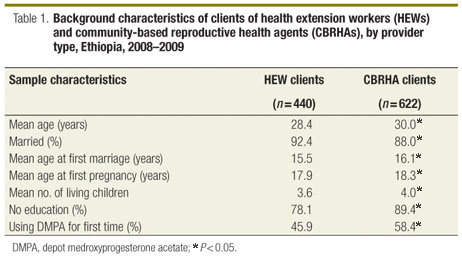
The objective of the present study was to assess the current capacity for essential surgical and anaesthesia care in the Gambia for the purpose of providing a benchmark for critical areas needing improvement.
Methods
Assessment of surgical resources
In June 2008, a team from the Global Initiative for Emergency and Essential Surgical Care (GIEESC) of the World Health Organization (WHO) visited 11 health facilities in the Gambia to assess potential sites for implementation of the WHO Emergency and Essential Surgical Care programme. The selected sites were organized in collaboration with the Gambia's Ministry of Health and WHO country office to provide broad geographical coverage of the country. The WHO Tool for Situation Analysis to Assess Emergency and Essential Surgical Care survey was subsequently distributed to health-care management officials at facilities throughout the country.4 Data were collected during April 2009 and surveys were completed by 65 of 76 health facilities (85.5% response rate) in the Gambia, including one tertiary referral hospital (1.5%), 7 (10.8%) district/general hospitals, 46 (70.8%) health centres and 11 (16.9%) private health facilities.
The survey included 110 questions divided into four sections. Section I consisted of 23 questions concerning infrastructure and type of health-care facility, the characteristics of the surgical population served, and the availability of oxygen, running water and electricity. Section II included 8 questions on human resources, including the number of specialist surgeons and anaesthesiologists, physicians, nurses and non-physician professionals who were providing surgery or anaesthesia services. Section III included 10 questions to assess emergency interventions such as resuscitation, suturing, cricothyroidotomy and burn management, as well as other surgical interventions such as caesarean section, fractures, hernia and laparotomy. Section IV consisted of 69 questions on the availability of emergency equipment and supplies for resuscitation, including capital outlays, renewable items and supplementary equipment.
Data from the questionnaires was complemented by interviews with health facility staff, government officials in the Ministry of Health and representatives of nongovernmental organizations (NGOs) responsible for health facilities. The additional content covered the state of health care in the Gambia and the challenges of administering surgical and anaesthesia services in a resource-constrained setting.
We used Stata version 10.0 (StataCorp. LP, College Station, United States of America) to perform the statistical analysis. We employed descriptive statistical methods to compare individual elements of the survey between public health facilities (i.e. the Royal Victoria Teaching Hospital [RVTH], general hospitals and health centres) and private hospitals. We performed bivariate analysis using Fisher's exact test to compare the results for public health facilities and private hospitals, with significance set at P < 0.05.
Results
Health facility characteristics
Of the 65 facilities that responded to the survey, 18 (27.7%) were considered referral hospitals capable of delivering surgical services. Data analysis was therefore focused on these 18 facilities, which included the country's tertiary referral hospital (5.6%), 5 (27.8%) general hospitals, 6 (33.3%) health centres and 6 (33.3%) private hospitals. The populations served by each facility ranged from 25 600 to 400 900.
Health infrastructure
Table 2 depicts the key infrastructural elements available in the health facilities assessed. Consistent sources of oxygen supply, running water and electricity were available at 14 (77.8%), 9 (50.0%) and 8 (44.4%) of facilities, respectively. Functioning power generators and anaesthesia machines were available at 9 (52.9%) and 12 (70.6%) facilities, respectively, and 4 (23.5%) health facilities reported having no functioning anaesthesia machines. A comparison of public health facilities with private hospitals showed that a significantly higher fraction of private facilities had running water consistently available (P = 0.009), functioning power generators (P = 0.009) and an uninterrupted supply of electricity (P = 0.002).
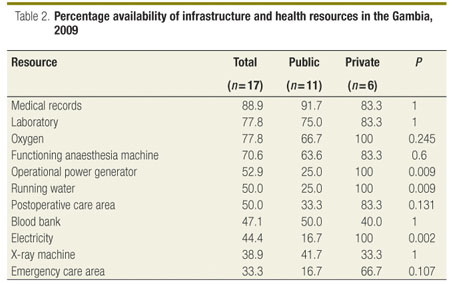
All 18 of the health facilities studied had at least one functioning operating room. The RVTH had four; two functioning operating rooms existed in two of the five (45.5%) remaining public facilities and in two (33.3%) of the private facilities. The RVTH had 576 beds; the number of beds ranged from 51 to 300 in other general hospitals, from 3 to 100 in health centres and from 11 to 50 in private hospitals.
Human resources
Table 3 shows health facility surgical and anaesthesia staff. Only 7 (38.9%) facilities had a surgeon, including the RVTH, which had 8; 3 (16.7%) facilities had a general doctor performing surgery. Only 3 (16.7%) facilities reported relying on paramedical staff such as surgical technicians to perform basic surgical procedures. Anaesthesia was delivered by anaesthesiologists in 4 (22.2%) facilities, general doctors in 1 (5.6%) facility and non-physicians in the rest. Only one obstetrician/gynaecologist was available in 8 (44.4%) of the facilities assessed. Most facilities (83.3%) had several paramedics and midwives who performed minor surgical interventions.
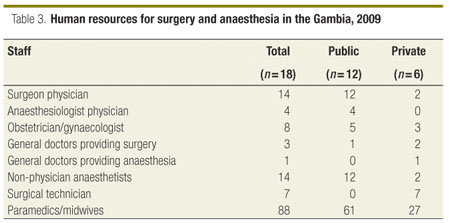
General and trauma surgery
The ability of each health facility to provide several basic surgical procedures was assessed (Table 4). All general hospitals reported performing at least 100 surgeries annually; 4 (66.7%) of them performed more than 500 per year. Health centres reported from 11 to 300 annual surgical admissions, while general hospitals reported from 100 to more than 5000. Surgical admissions to private hospitals ranged from 11 to 200 a year.
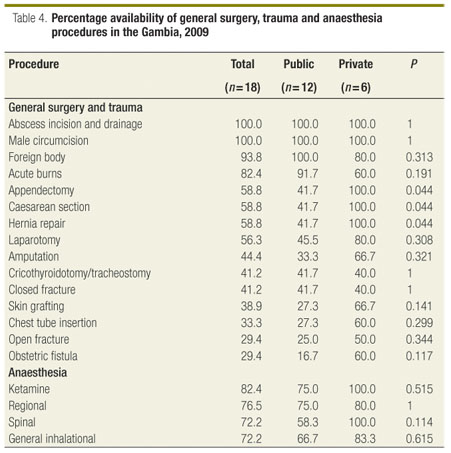
All facilities were able to perform incision and drainage of abscesses and male circumcision. Laparotomies were performed in 56.3% of facilities. Compared with public facilities, a significantly greater percentage of private facilities performed appendectomies, caesarean sections and hernia repairs (P = 0.044). Only 5 (29.4%) facilities repaired obstetric fistulas. Management guidelines for surgical care were available in only 10 (55.6%) facilities.
Regarding trauma procedures, 93.8% of facilities removed foreign bodies and 82.4% managed burns. Cricothyroidotomy/tracheostomy and chest tube insertion were performed in only 41.2% and 33.3% facilities, respectively. Management guidelines for emergency care were available in only 8 (44.4%) facilities. Patients needing procedures not performed in health facilities and hospitals because of a lack of skilled personnel, equipment or supplies were referred to tertiary facilities.
Of the health facilities without official operating rooms, several managed to carry out basic life-saving procedures including burn management (72.7%), incision and drainage of abscesses (81.8%) and foreign body removal (66.7%). More technically difficult or equipment-intensive procedures such as appendectomy (2.3%), laparotomy (4.8%) and open fracture repair (2.5%) were less frequently available.
Anaesthesia
The availability of the resources needed to provide anaesthesia services was assessed (Table 4). The most common types of anaesthesia provided were ketamine intravenous anaesthesia (82.4%) and regional anaesthesia (76.5%), while spinal (72.2%) and general inhalational (72.2%) anaesthesia were also available. Management guidelines for anaesthesia and pain management were available in 10 (58.8%) and 5 (27.8%) facilities, respectively.
Emergency and sterilization equipment and supplies
The availability of emergency equipment and supplies was assessed in each of the health facilities (Table 5). Resuscitator bags were available in 10 (58.8%) facilities, while 12 (66.7%) facilities reported having intravenous infusion sets. Nasogastric tubes were available in 7 (38.9%) facilities, and examination gloves and sterile gloves were available in 12 (66.7%) and 10 (55.6%) facilities, respectively. Sterilizers were consistently available in 9 (52.9%) facilities, while other sterilization methods, including cold sterilization and boiling, were used in the remainder. Only 3 (18.8%) facilities reported having adequate eye protection for health staff and 6 (35.3%) reported having enough protective aprons.
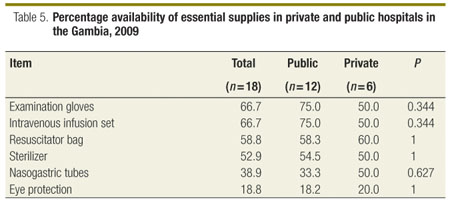
Discussion
Although surgery is a cost-effective element of preventive health care,1 access to essential surgery is limited in most resource-constrained settings.510 This is the first survey to assess the status of essential and emergency surgical care and of anaesthesia services in the Gambia. The most striking finding was the absence of any facilities equipped with all of the physical resources needed to provide emergency and essential surgical care. Major gaps in the physical resources needed to carry out basic surgical and anaesthetic care in the Gambia were identified. These included deficits in the availability of water, electricity, oxygen, and emergency and anaesthesia equipment.
The WHO Tool for Situation Analysis to Assess Emergency and Essential Surgical Care was used to assess surgical capacity in several countries. In Afghanistan, 30% of facilities had limited oxygen delivery mechanisms, 40% had unreliable sources of running water and only 34% had uninterrupted electrical power.9 Comparatively, in the Gambia reliable sources of oxygen, running water and electricity were available in 77.8%, 50.0% and 44.4% of facilities. In Sierra Leone, only 20% of facilities had functioning anaesthesia machines8 compared with 75.0% in the Gambia. In Ghana, a shortage of adequately trained human resources was identified as the major barrier to the delivery of surgical and anaesthetic services; 88% of facilities could perform caesarean sections and 94% could perform appendectomies.10 Human resource shortages were also identified as an obstacle in the Gambia, where only 58.8% of facilities were performing caesarean sections and appendectomies. Thus, surgical and anaesthesia services in the Gambia are at an intermediate level when compared with those of neighbouring countries.
Access to care
In the Gambia, inequitable access to surgical services is propitiated to some extent by the concentration of health facilities and staff in urban areas such as the Western Division.11 As a result of poorly developed referral systems and a lack of physicians in secondary health facilities, many patients are referred to distant health facilities for basic procedures that should be performed at the primary and secondary levels. Health centres and private hospitals will first refer cases to district hospitals before referring them to the RVTH. Unfortunately, the RVTH is already overstretched and faces human and physical resource challenges similar to those faced by the institutions assessed in this project. Moreover, the Gambian River, which divides the country, further hinders access to basic surgery facilities by limiting transportation from distant rural areas to Banjul. Although improved transportation to more distant facilities with better equipment may temporarily help reduce these inequities, it is not a sustainable solution for patients requiring urgent assessment and management. Policies in support of resource allocation for improving district-level access to surgical care that can save lives and prevent disability are needed to relieve the burden on tertiary-level health facilities such as the RVTH.
Human resources
The shortage of health personnel at the primary level is also a major obstacle to the provision of surgical and anaesthesia services in the Gambia (Table 3). Although several health services have been expanded, staffing does not meet the needs of the institutions or their catchment areas. The Gambia has less than 0.5 physicians per 10 000 inhabitants, compared with 2.4 per 10 000 in the WHO African Region.3 Moreover, most (80%) of the practicing physicians are not of Gambian nationality.11 The brain drain is pervasive because many health workers leave the public health system to work in the private sector, in NGOs or in other countries.1214 To compensate for the lack of trained personnel, health facilities have increasingly relied on paramedical staff to meet their surgical and anaesthesia needs. Despite the noticeable lack of surgeons in many of the facilities assessed in this study, every facility had ample nursing and health-care staff.
General surgery and trauma
Access to essential surgery and emergency services is a key determinant of health,15 yet many basic procedures, including amputation, fracture repair and chest tube insertion, were not provided in many of the facilities assessed in our study. Many also lacked management guidelines for emergency, anaesthesia and surgical care.16 Thus, implementing the aforementioned guidelines in all health facilities could be a cost-effective intervention for preventing surgical complications and reducing morbidity and mortality.
The widespread availability of male circumcision is encouraging, given the role of this procedure in HIV prevention efforts (Table 1 and Table 4).17 A greater percentage of private hospitals than public ones performed hernia repair, appendectomy and caesarean section. Other studies have documented disparities in infrastructure, supplies and equipment between public and private health-care facilities in the developing world.18,19 Our findings indicate that in the Gambia private facilities may be better equipped to perform certain procedures than public ones. In addition, private facilities reported greater reliance on surgical technicians and paramedical staff for providing health services (Table 3), perhaps a reflection of the country's historical reliance on nurses and other paramedical staff for procedures such as cataract and lens extraction.20 Non-physicians in countries such as the Democratic Republic of the Congo, Kenya, Malawi and Mozambique have performed basic surgical procedures for years with outcomes equivalent to those observed when specialists perform them.2124 Strengthening the training of mid-level health-care providers in the Gambia in emergency, surgical and anaesthesia procedures at the district level would certainly help to attenuate the human resource crisis and fulfil part of the unmet need for basic surgical care.
Although surgery is a specialized activity that cannot be made available in every facility, certain emergency procedures and techniques, such as burn management, should be more widely available. Despite the lack of an operating room, several facilities not included in the statistical analysis performed several basic emergency and essential surgical procedures. Increasing the capacity of these centres to provide essential surgical care may also help to reduce the burden of conditions requiring surgery in the Gambia.
The Gambian government, having recognized the enormous deficits that exist within the health-care system, has tried to provide citizens with improved access to better surgical and anaesthetic care. The nation's only medical school, established in 2000, has integrated surgery into the medical school curriculum to encourage students to pursue surgical careers. The Ministry of Health has established a successful collaboration with the World Health Organization and two international organizations to advance the state of maternal and child health through improved delivery of emergency and obstetric services at one site in the Gambia.25 Similar collaborations would also help to overcome the lack of other necessary surgical procedures in the Gambia. More system-wide changes are needed to create a sustainable mechanism for procuring and maintaining the supplies and technical skills required to perform surgery safely.
Anaesthesia
A global anaesthesia workforce crisis is emerging.26,27 Our work highlights the shortage of trained anaesthesia providers and services in the Gambia, where anaesthesia in referral hospitals is delivered primarily by nurses and clinical officers. Thus, it is thus extremely important to ensure appropriate training in the country and to motivate health-care workers to pursue careers in anaesthesiology. The WHO Integrated Management for Emergency and Essential Surgical Care toolkit provides management guidelines that should be incorporated in the training when building surgical capacity in non-surgical programmes in district- and sub-district-level health facilities that have no surgery specialists.
As in other resource-limited health settings, in the Gambia ketamine-based anaesthesia (82.4%) was the type most commonly available in the health facilities assessed.28 This may reflect a shortage of the skills and equipment needed to provide spinal and general anaesthesia.
Challenges with partnerships
Increased mortality has been correlated with deficits in health infrastructure,29 medical technology30 and integration of resources to provide surgical services.31 The capacity of health facilities to provide basic life-saving interventions must be strengthened. Multidisciplinary partnerships, such as between governments and NGOs, offer welcome opportunities to improve health care in countries such as the Gambia and to develop solutions that can generate important changes. The Global Initiative for Emergency and Essential Surgical Care (GIEESC) was established by WHO in 2005 to reduce death and disability associated with surgical conditions.32 Through technical assistance, needs assessments and education and training, the GIEESC strengthens resource-limited countries' capacity to deliver safe and effective emergency surgical care. Our study suggests that the GIEESC can play an important role in bringing together stakeholders interested in building surgical capacity in primary health-care facilities and in ensuring the availability of material resources and of properly trained human resources.
Our study has limitations. First, the sample was taken only from facilities offering surgery and anaesthesia services. Second, some of the assessed facilities may have undergone significant infrastructural improvements since the time of the survey, although this is unlikely. Despite these limitations, the data presented accurately reflect the Gambia's current capacity to provide surgery and anaesthesia services.
The WHO tool has been validated for assessing the capacity of health facilities in the developing world.33 Although good test-retest reliability has been documented for the sections covering physical infrastructure, equipment and human resources, those parts that pertain to the process of delivering health care can benefit from supplemental data. Overall, the WHO tool makes it possible to quickly assess health facilities' capacity for delivering essential surgical and anaesthetic services and to compare data across developing countries.
Conclusion
In conclusion, the Gambia faces many obstacles to the delivery of surgical and anaesthesia services, including a shortage of human resources, equipment, supplies and infrastructure. Future studies are needed to help determine precisely how the shortage in each area affects surgical outcomes. To effectively reduce death and disability from surgical conditions, efforts to improve surgical capacity within the Gambian health-care system must focus on the district level. Training mid-level health practitioners in surgery and developing partnerships between the government and NGOs may be important steps towards improving surgical and anaesthetic services in the Gambia. 
Acknowledgements
We are grateful for the support of the health facility visit team, including Agnes Kuye, Alpha Jallow and Thomas Sukwa (World Health Organization Country Office, the Gambia), Momodou Baro (Royal Victoria Teaching Hospital, Banjul, the Gambia) and Yankuba Kassama (Ministry of Health, the Gambia).
Funding: This work was supported by the Johns Hopkins Center for Global Health (grant number 5R25TW007506) from the Fogarty International Center at the National Institutes of Health.
Competing interests: None declared.
References
1. Debas H, Gosselin R, McCord C, Thind A. Surgery. In: Jamison D, editor. Disease control priorities in developing countries. 2nd edition. New York: Oxford University Press; 2006. pp. 1245-59.
2. Human development report 2010 20th anniversary edition: the real wealth of nations: pathways to human development. New York: United Nations Development Programme; 2010.
3. Global Health Observatory 2010 [Internet]. Geneva: World Health Organization; 2010. Available from: http://apps.who.int/ghodata [accessed 19 April 2011] .
4. WHO tool for situational analysis to assess emergency and essential surgical care [Internet]. Geneva: World Health Organization; 2011. Available from: www.who.int/entity/surgery/publications/QuickSitAnalysisEESCsurvey.pdf [accessed 19 April 2011] .
5. Chianakwana GU, Ihegihu CC, Okafor PI, Anyanwu SN, Mbonu OO. Adult surgical emergencies in a developing country: the experience of Nnamdi Azikiwe University Teaching Hospital, Nnewi, Anambra State, Nigeria. World J Surg 2005;29: 8047, discussion 808. doi: 10.1007/s00268-005-7670-y PMID: 15880283
6. Meo G, Andreone D, De Bonis U, Cometto G, Enrico S, Giustetto G et al. Rural surgery in southern Sudan. World J Surg 2006;30: 495504. doi: 10.1007/s00268-005-0093-y PMID: 16547612
7. Ozgediz D, Dunbar P, Mock C, Cherion M, Rogers SO Jr, Riviello R et al. Bridging the gap between public health and surgery: access to surgical care in low- and middle-income countries. Bull Am Coll Surg 2009;94: 1420. PMID: 19469376
8. Kingham TP, Kamara TB, Cherian MN, Gosselin RA, Simkins M, Meissner C et al. Quantifying surgical capacity in Sierra Leone: a guide for improving surgical care. Arch Surg 2009;144: 1227, discussion 128. doi: 10.1001/archsurg.2008.540 PMID: 19221322
9. Contini S, Taqdeer A, Cherian M, Shokohmand AS, Gosselin R, Graaff P et al. Emergency and essential surgical services in Afghanistan: still a missing challenge. World J Surg 2010;34: 4739.
10. Choo S, Perry H, Hesse AA, Abantanga F, Sory E, Osen H et al. Assessment of capacity for surgery, obstetrics and anaesthesia in 17 Ghanaian hospitals using a WHO assessment tool. Trop Med Int Health 2010;15: 110915. PMID: 20636302
11. Country Cooperation Strategy WHO. 20082013: Gambia. Geneva: World Health Organization; 2011. Available from: http://www.who.int/countryfocus/cooperation_strategy/ccs_gmb_en.pdf [accessed 19 April 2011] .
12. Ozgediz D, Galukande M, Mabweijano J, Kijjambu S, Mijumbi C, Dubowitz G et al. The neglect of the global surgical workforce: experience and evidence from Uganda. World J Surg 2008;32: 120815. doi: 10.1007/s00268-008-9473-4 PMID: 18299920
13. Mullan F. The metrics of the physician brain drain. N Engl J Med 2005;353: 18108. doi: 10.1056/NEJMsa050004 PMID: 16251537
14. Stilwell B, Diallo K, Zurn P, Vujicic M, Adams O, Dal Poz M. Migration of health-care workers from developing countries: strategic approaches to its management. Bull World Health Organ 2004;82: 595600. PMID: 15375449
15. Pemberton J, Cameron B. Essential surgical services: an emerging primary health care priority. MUMJ 2010;7: 510.
16. Haynes AB, Weiser TG, Berry WR, Lipsitz SR, Breizat AH, Dellinger EP et al.; Safe Surgery Saves Lives Study Group. A surgical safety checklist to reduce morbidity and mortality in a global population. N Engl J Med 2009;360: 4919. doi: 10.1056/NEJMsa0810119 PMID: 19144931
17. Williams BG, Lloyd-Smith JO, Gouws E, Hankins C, Getz WM, Hargrove J et al. The potential impact of male circumcision on HIV in sub-Saharan Africa. PLoS Med 2006;3: e262. doi: 10.1371/journal.pmed.0030262 PMID: 16822094
18. Nantulya VM, Reich MR. The neglected epidemic: road traffic injuries in developing countries. BMJ 2002;324: 113941. doi: 10.1136/bmj.324.7346.1139 PMID: 12003888
19. Aggarwal SK. Problems of radiology in the Indian subcontinent. Invest Radiol 1993;28(Suppl 3): S323. doi: 10.1097/00004424-199308003-00017 PMID: 8376057
20. Blanchard RJ, Merrell RC, Geelhoed GW, Ajayi OO, Laub DR, Rodas E. Training to serve unmet surgical needs worldwide. J Am Coll Surg 2001;193: 41727. doi: 10.1016/S1072-7515(01)01037-7 PMID: 11584970
21. Pereira C, Cumbi A, Malalane R, Vaz F, McCord C, Bacci A et al. Meeting the need for emergency obstetric care in Mozambique: work performance and histories of medical doctors and assistant medical officers trained for surgery. BJOG 2007;114: 15303. doi: 10.1111/j.1471-0528.2007.01489.x PMID: 17877775
22. White SM, Thorpe RG, Maine D. Emergency obstetric surgery performed by nurses in Zaïre. Lancet 1987;2: 6123. doi: 10.1016/S0140-6736(87)92996-5 PMID: 2887896
23. Vaz F, Bergström S, Vaz MdaL, Langa J, Bugalho A. Training medical assistants for surgery. Bull World Health Organ 1999;77: 68891. PMID: 10516791
24. Dovlo D. Using mid-level cadres as substitutes for internationally mobile health professionals in Africa: a desk review Hum Resour Health 2004;2: 7. doi: 10.1186/1478-4491-2-7 PMID: 15207010
25. Cole-Ceesay R, Cherian M, Sonko A, Shivute N, Cham M, Davis M et al. Strengthening the emergency healthcare system for mothers and children in The Gambia. Reprod Health 2010;7: 21. doi: 10.1186/1742-4755-7-21 PMID: 20718979
26. Dubowitz G, Detlefs S, McQueen KA. Global anesthesia workforce crisis: a preliminary survey revealing shortages contributing to undesirable outcomes and unsafe practices. World J Surg 2010;34: 43844. doi: 10.1007/s00268-009-0229-6 PMID: 19795163
27. Cherian M, Choo S, Wilson I, Noel L, Sheikh M, Dayrit M et al. Building and retaining the neglected anaesthesia health workforce: is it crucial for health systems strengthening through primary health care? Bull World Health Organ 2010;88: 6379. doi: 10.2471/BLT.09.072371 PMID: 20680130
28. Hodges SC, Walker IA, Bösenberg AT. Paediatric anaesthesia in developing countries. Anaesthesia 2007;62(Suppl 1): 2631. doi: 10.1111/j.1365-2044.2007.05294.x PMID: 17937710
29. Dünser MW, Baelani I, Ganbold L. A review and analysis of intensive care medicine in the least developed countries. Crit Care Med 2006;34: 123442. doi: 10.1097/01.CCM.0000208360.70835.87 PMID: 16484925
30. Bastos PG, Knaus WA, Zimmerman JE, Magalhães A Jr, Sun X, Wagner DP; Brazil APACHE III Study Group. The importance of technology for achieving superior outcomes from intensive care. Intensive Care Med 1996;22: 6649. doi: 10.1007/BF01709743 PMID: 8844231
31. De Brouwere V, Tonglet R, Van Lerberghe W. Strategies for reducing maternal mortality in developing countries: what can we learn from the history of the industrialized West? Trop Med Int Health 1998;3: 77182. doi: 10.1046/j.1365-3156.1998.00310.x PMID: 9809910
32. Bickler SW, Spiegel D. Improving surgical care in low- and middle-income countries: a pivotal role for the World Health Organization. World J Surg 2010;34: 38690. doi: 10.1007/s00268-009-0273-2 PMID: 19876687
33. Osen H, Chang D, Choo S, Perry H, Hesse A, Abantanga F et al. Validation of the World Health Organization tool for situational analysis to assess emergency and essential surgical care at district hospitals in Ghana. World J Surg 2011;35: 5004. doi: 10.1007/s00268-010-0918-1 PMID: 21190114
(Submitted: 16 February 2011 Revised version received: 4 April 2011 Accepted: 10 April 2011 Published online: 6 May 2011)
* Correspondence to Adam Iddriss (e-mail: iddriss@jhmi.edu).
